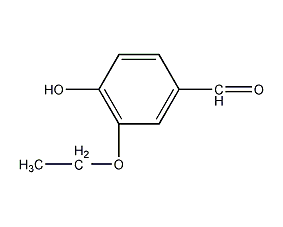
Structural formula
| Business number | 03DD |
|---|---|
| Molecular formula | C9H10O3 |
| Molecular weight | 166.17 |
| label |
Ethylvanylline, Ethyl vanillin, 3-ethoxy-4-hydroxybenzaldehyde, Ethyl vanillin, Bourbon aldehyde, Ethylcatechualdehyde, Ethyl vanillin, Bourbonal, food additives, Flavor enhancer |
Numbering system
CAS number:121-32-4
MDL number:MFCD00006944
EINECS number:204-464-7
RTECS number:CU6125000
BRN number:1073761
PubChem number:24845374
Physical property data
1. Properties: white to light yellow needle-like crystals, aroma similar to vanillin, but more intense. Its aroma intensity is 3-4 times that of vanillin.
2. Melting point (℃): 77
3. Boiling point (ºC, 1.73kpa): 149~150
4. Solubility: soluble in alcohol , ether, chloroform, also soluble in sodium hydroxide solution.
5. Flash point (ºC): 145
6. Relative density (d204) : 1.186
p>
7. Ignition point (℃): 46
Toxicological data
1. Acute toxicity: Rat oral LD50: 1590mg/kg
Rat subcutaneous LDL0: 1800mg/kg
Mouse peritoneal cavity LD50: 750mg/kg
Dog intravenous LDL0: 760mg/kg
Rabbit oral LDL0: 3g/kg
Rabbit skin LD50: >7940mg/kg
Guinea pig transperitoneal cavity LD50: 1140mg/kg
2. Other multiple dose toxicity: Rat oral TDLO: 4480mg/kg/70D-I
3. Mutagenicity: Human lymphocyte double chromosome exchange test: 1mmoL/L
Hamster fibroblast analysis test: 250mg/L
Ecological data
None
Molecular structure data
1. Molar refractive index: 46.19
2. Molar volume (cm3/mol): 140.0
3. Isotonic specific volume (90.2K): 363.7
4. Surface tension (dyne/cm): 45.5
5. Dielectric constant:
6. Dipole moment (10-24 cm3):
7. Polarizability: 18.31
Compute chemical data
1. Reference value for hydrophobic parameter calculation (XlogP): None
2. Number of hydrogen bond donors: 1
3. Number of hydrogen bond acceptors: 3
4. Number of rotatable chemical bonds: 3
5. Number of tautomers: 5
6. Topological molecule polar surface area 46.5
7. Number of heavy atoms: 12
8. Surface charge: 0
9. Complexity: 147
10. Number of isotope atoms: 0
11. Determine the origin�Number of stereocenters: 0
12. Uncertain number of stereocenters of atoms: 0
13. Determined number of stereocenters of chemical bonds: 0
14 .The number of uncertain chemical bond stereocenters: 0
15. The number of covalent bond units: 1
Properties and stability
Storage method
None
Synthesis method
1. Prepared from o-ethoxyphenol as raw material. This method is similar to the process of vanillin. O-ethoxyphenol can also be reacted with glyoxylic acid, and then heated and oxidized with copper oxide and caustic soda aqueous solution to generate ethyl vanillin. Not only vanillin but also ethyl vanillin can be produced from safrole. Heat the alcohol solution of safrole (4-allyl-1,2-methylenedioxybenzene) and potassium hydroxide in an autoclave to destroy its dioxy ring. Then use sodium ethyl sulfate and a 50% potassium hydroxide solution of the product to heat for 2-3 hours at 150-155°C for etherification. The etherified phenolic mixture is dissolved in 50% ethanol, and then a small amount of sulfuric acid is added and heated under reflux to hydrolyze it to produce concentrated vanillin and isoeugenol. The former precipitates into scaly crystals, is filtered, and then recrystallized with 50% ethanol to obtain the pure product. Separate the isoeugenol-like substance from the filtrate and dissolve it in 10% sodium hydroxide solution. Add sodium m-nitrobenzene sulfonate and reflux for 3 hours. After cooling, acidify with dilute sulfuric acid to generate ethyl vanillin. The oil produced by acidification is extracted with benzene, then extracted with 35% sodium bisulfite solution, and recrystallized after acidification to obtain the finished product.
2.Condensation of o-ethoxyphenol, p-nitrosodimethylaniline hydrochloride and methenamine, after extraction, Produced by distillation and refining. Or it can be obtained by condensation of o-ethoxyphenol and glyoxylic acid and heating and oxidation. It can also be obtained by condensation of o-ethoxyphenol and trichloroacetaldehyde, followed by hydrolysis and chlorination. It can also be obtained by the reaction of catechin and sodium ethyl sulfate, followed by distillation, extraction and fractionation.
Purpose
1. This product has the aroma of vanillin, but it is more elegant than vanillin, and the aroma intensity is 3-4 times higher than that of vanillin. It is widely used in the preparation of various types of flavors, and is used as a fixative, Flavoring agents are used in the production of cosmetics, soaps, cigarettes, cakes, candies, beverages and other industries, and are widely used in food flavors.
2.Ethyl vanillin is a broad-spectrum fragrance and one of the most important synthetic fragrances in the world today. Its aroma is 3 to 4 times that of methyl vanillin. It has a rich vanilla bean aroma and a long-lasting aroma. It is widely used in food, chocolate, ice cream, beverages and daily cosmetics to enhance and fix fragrance. The dosage used in chocolate is 250mg/kg; in gum candy it is 110mg/kg; 100 mg/kg in alcoholic beverages; 74 mg/kg in puddings ; 65mg/kg in candies; 63mg/kg in baked goods ; 47mg/kg in cold drinks; 20mg/kg in soft drinks span>. It can also be used as a feed additive; a brightener in the electroplating industry; and an intermediate in the pharmaceutical industry.

 微信扫一扫打赏
微信扫一扫打赏

